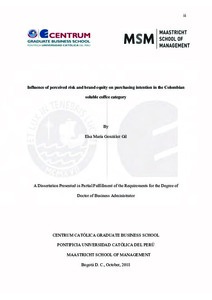| dc.contributor.advisor | Arias Bolzmann, Leopoldo Gabriel Ignacio | |
| dc.contributor.author | González Gil, Elsa María | |
| dc.date.accessioned | 2019-09-17T17:08:24Z | |
| dc.date.available | 2019-09-17T17:08:24Z | |
| dc.date.created | 2018-10 | |
| dc.date.issued | 2019-09-17 | |
| dc.identifier.uri | http://hdl.handle.net/20.500.12404/15014 | |
| dc.description.abstract | Different authors have defined purchase intention when a person makes a statement
as to whether to buy, or not a product. It has been considered an important indicator in
marketing management to project sales of new and existing products (Armstrong, Morwitz, &
Kumar, 2000; Huy & Ottar, 2012). The purpose of the research was to identify how using
all the set of variables of brand equity and perceived risk could influence purchase intention
within soluble coffee consumers in Colombia, using attitude as a mediating variable. The
city selected for this research was Bogotá D.C., and the category selected was soluble coffee.
The sample size was 927 people and the sample error was 3.2% with 99% level of
confidence. The research type was probabilistic, and it used a proportional stratified sample.
In order to answer the research proposed questions, three steps were carried out, (a)
exploratory factor analysis, (b) confirmatory factor analysis and, (c) structural equations
model where seven hypotheses were tested. The initial model considered six latent variables
on perceived risk and brand equity each; however, the final model included five variables on
brand equity and four on perceived risk. The results obtained, confirmed the influence of
attitude as a mediating variable between brand equity and perceived risk on purchase
intention within consumers of soluble coffee in the city of Bogotá D. C. Purchase intention
was explained by the direct effect of attitude variable and the indirect effects of perceived
risk and brand equity. In addition, it also explained the indirect effects that perceived risk has
on attitude through brand equity. The variables of brand equity and perceived risk used in the
model show that, the effect is much greater when they are included, as joint independent
variables. The model also was able to test the significance and positive influence of attitude
as a mediating variable between perceived risk and brand equity, on purchase intention. The
results obtained from this research showed a very good consistency between each variable
and their corresponding items used for each. | es_ES |
| dc.language.iso | eng | es_ES |
| dc.publisher | Pontificia Universidad Católica del Perú | es_ES |
| dc.rights | info:eu-repo/semantics/closedAccess | es_ES |
| dc.subject | Café--Industria y comercio--Colombia | es_ES |
| dc.subject | Mercadeo | es_ES |
| dc.subject | Investigación cuantitativa | es_ES |
| dc.title | Influence of perceived risk and brand equity on purchasing intention in the Colombian soluble coffee category | es_ES |
| dc.type | info:eu-repo/semantics/doctoralThesis | es_ES |
| thesis.degree.name | Doctor en Administración Estratégica de Empresas | es_ES |
| thesis.degree.level | Doctorado | es_ES |
| thesis.degree.grantor | Pontificia Universidad Católica del Perú. CENTRUM | es_ES |
| thesis.degree.discipline | Administración Estratégica de Empresas | es_ES |
| renati.advisor.dni | 07769580 | |
| renati.author.cext | AS909025 | |
| renati.discipline | 413038 | es_ES |
| renati.level | https://purl.org/pe-repo/renati/level#doctor | es_ES |
| renati.type | http://purl.org/pe-repo/renati/type#tesis | es_ES |
| dc.publisher.country | PE | |
| dc.subject.ocde | https://purl.org/pe-repo/ocde/ford#5.02.04 | es_ES |





